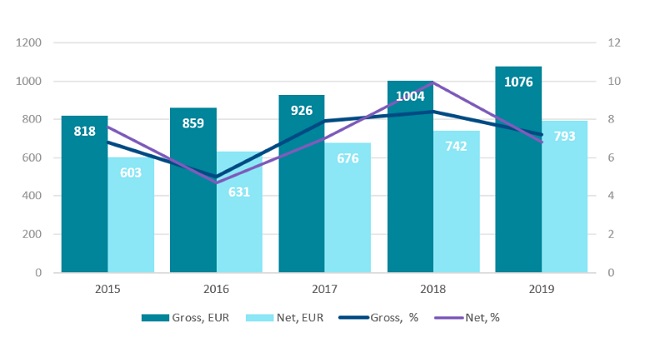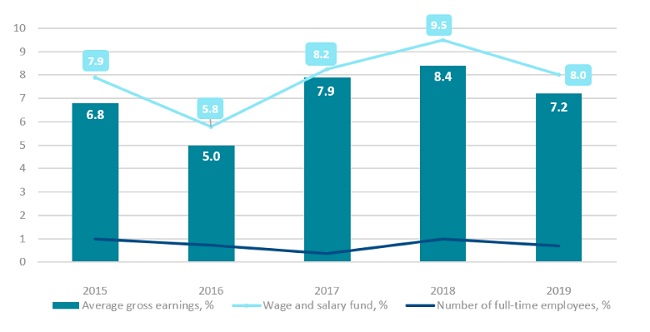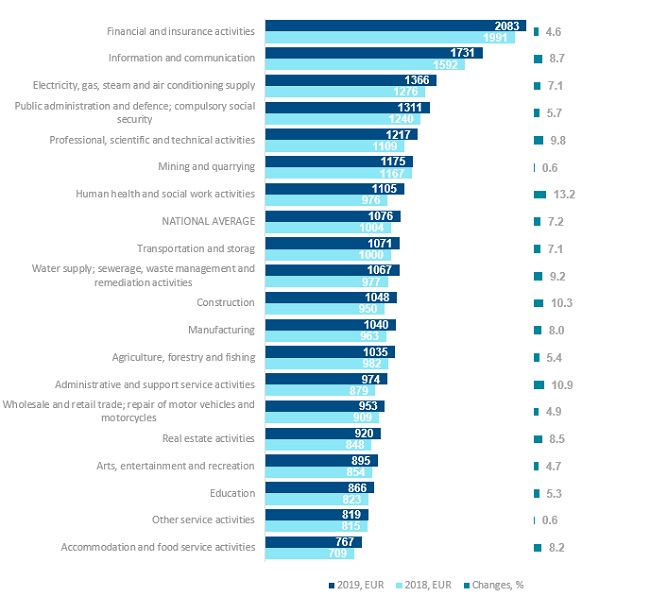Analytics, Latvia, Statistics, Wages
International Internet Magazine. Baltic States news & analytics
Wednesday, 07.01.2026, 21:55
Latvia: In 2019, average earnings before taxes amounted to EUR 1 076
 Print version
Print versionAverage wages and salaries after taxes constitute EUR 793
Average net wages and salaries (calculated based on labour taxes applicable on workplace) comprised EUR 793 or 73.7% of gross earnings. Over the year, net wages and salaries increased by 6.8%, showing 0.4 percentage points lower rise than that of wages and salaries before taxes.
Considering the consumer price growth of 2.8% in 2019, the real increase of the wages and salaries comprised 3.9%.
Median wages and salaries comprised EUR 832
In 2019, median gross wages and salaries amounted to EUR 832, and, compared to EUR 774 in 2018, they grew faster than the mean arithmetic earnings (rise of 7.5%). In 2019, net median wages (after taxes) constituted EUR 613 and rose by 7.1% over the year.
Median is calculated based on the information available in statistical surveys and administrative data of the State Revenue Service.
Median is an average indicator located in the middle of employee earnings sorted in an ascending or descending order. As median, compared to the mean arithmetic earnings, is not influenced by extremely high or low wages and salaries, it reflects typical earnings more precisely.
Changes in average monthly wages and salaries

Changes in the average wages and salaries are influenced not only by the rise or decline in employee remuneration, but also structural changes of the labour market – enterprises that had started and stopped their business during the year, changes in the number of employees and workloads. The effects caused by the mentioned factors in general may be seen in the changes in the wage and salary fund and number of full-time employees, which are used in the average wage calculations.
In 2019, compared to 2018, gross wage and salary fund increased by 8.0% or EUR 724.7 mдn, whereas the number of salaried workers, recalculated into full-time units, grew by 0.7 % or 5.3 thousand.
Changes in average monthly gross earnings, wage and salary fund and number of full-time employees
(as %)

Sharper rise in earnings recorded in private sector
In 2019, the average gross wages and salaries in private sector constituted EUR 1 067, in public sector EUR 1 103, while in general government sector, which includes central and local government institutions, as well as enterprises controlled and financed by the central and local government, it amounted to EUR 1 055.
Wages and salaries in private sector grew faster (by 7.6% annually), rise in public sector comprised 6.8% and in general government sector 7.1% annually.
Sharpest rise recorded in human health and social care activities
Compared to 2018, the average wages and salaries grew in all economic activities. The sharpest increase (of 13.2%) was registered in human health and social care. Steep upturn was registered also in administrative and support service activities (of 10.9%), construction (10.3%), professional, scientific and technical activities (9.8%), as well as water supply; sewerage, waste management, and remediation activities (9.2%).
Growth in professional, scientific and technical activities was influenced by the decline in the number of full-time employees, while wage and salary fund increased. Wage and salary fund in the remaining of the above sectors grew more rapidly than the number of employees.
Average earnings above national average observed in seven economic activities
In 2019, average wages and salaries for full-time work exceeded the national average indicator in seven economic activities – financial and insurance activities, information and communication, energy sector, public administration, professional, scientific and technical activities, mining and quarrying, as well as human health and social work activities.
The lowest average earnings were recorded in accommodation and food service activities (EUR 767), other service activities (that includes activities of public and other organisations, repair of computers and personal and household goods, washing and (dry-)cleaning, hairdressing and other beauty treatment, funeral and related activities) (EUR 819), as well as education (EUR 866).
Average monthly earnings and changes thereof by economic activity; 2019

Average earnings in Latgale were 38 % lower than in Riga
Compared to 2018, in 2019 average gross monthly wages and salaries grew faster in Pierīga and Zemgale region – by 8.4% and 7.9%, respectively. Smaller growth was observed in Kurzeme (7.4%), Vidzeme and Latgale (7.1% in each region). The lowest average gross wages and salaries for full-time work were registered in Latgale – EUR 751, constituting 38% less than the earnings in Riga (EUR 1 206).
In Q4, average earnings before taxes amounted to EUR 1 114
In the 4th quarter of 2019, the average monthly gross wages and salaries in the country comprised EUR 1 114, and over the year they have grown by 6.9%, which is the lowest annual growth, compared to other quarters of 2019. In the 4th quarter of 2019, the share of irregular bonuses and premiums in the total earnings constituted 7.1% (approximately 5.0% in other quarters).
Compared to the 4th quarter of 2018, in the 4th quarter of 2019 the highest rise in the average wages and salaries was recorded in private sector – of 7.5%, in public sector it constituted 6.1% and in general government sector 7.2%.
Compared to the 3rd quarter of 2019, gross wages and salaries in the country grew by 2.8%. Sharper increase was observed in public sector – 2.9%, compared to 2.7% in private sector. The average wages and salaries in general government sector went up by 3.1%.
In the 4th quarter, net wages and salaries amounted to EUR 818, and, compared to the 4th quarter of 2018, they went up by 6.5%. Compared to the 3rd quarter of 2019, wages and salaries rose by 2.8%.
- 28.01.2022 BONO aims at a billion!
- 25.01.2021 Как банкиры 90-х делили «золотую милю» в Юрмале
- 30.12.2020 Накануне 25-летия Балтийский курс/The Baltic Course уходит с рынка деловых СМИ
- 30.12.2020 On the verge of its 25th anniversary, The Baltic Course leaves business media market
- 30.12.2020 Business Education Plus предлагает анонсы бизнес-обучений в январе-феврале 2021 года
- 30.12.2020 Hotels showing strong interest in providing self-isolation service
- 29.12.2020 В Латвии вводят комендантский час, ЧС продлена до 7 февраля
- 29.12.2020 В Rietumu и в этот раз создали особые праздничные открытки и календари 2021
- 29.12.2020 Latvia to impose curfew, state of emergency to be extended until February 7
- 29.12.2020 18-19 января Наталия Сафонова проводит семинар "Управленческий учет во власти собственника"








 «The Baltic Course» Is Sold and Stays in Business!
«The Baltic Course» Is Sold and Stays in Business!

